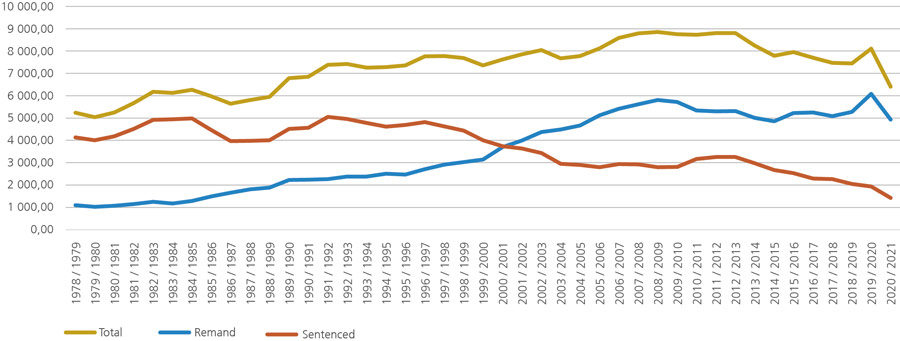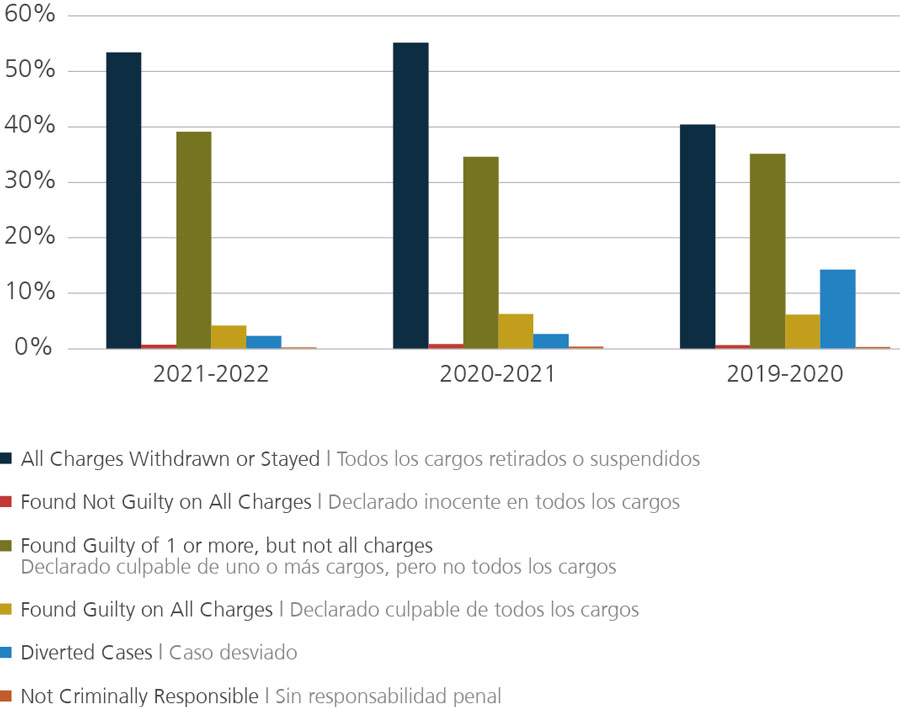Noteworthy Practice
Toronto Bail Program
In the late 1970s the Province of Ontario faced a considerable challenge: jails’ overcrowding. With more than half of the incarcerated population awaiting trial, the province needed to build more facilities or develop alternatives.
The movement came at the heel of a series of bail system reforms, looking to resolve problems of lack of accessibility to existing pretrial release procedures.
There was mounting pressure to establish collateral verification and oversight programs that could provide courts with alternative ways to release suspects pending trial.
Based on previous experiences in the US and Canada, the Ministry of Correctional Services in Ontario turned to a solution involving verification and supervision in the community.
With successful results, the project was extended to all the Toronto Court Houses, while similar projects began in other cities. The project then became the Toronto Bail Program, a not-for-profit agency that operates until today.
Today, the Bail Verification and Supervision Program (BVSP) is provided province-wide through funding from the Ontario Ministry of the Attorney General, including Indigenous specific Bail Programs across the province.
Canada has seen its number of individuals under remand measures steadily rise (1). From 3.000 to 4.000 accused persons in this provision in the 80s, the number grew to 6.500 by the late 90s. Since 2004/2005, the amount of admitted individuals awaiting trial surpassed the sentenced ones in the provincial/territorial correctional services.
After reaching close to 14.000 people in remand in 2010, the numbers fluctuated between 11.500 and 15.500 during that decade.
The latest data(2) from 2020/2021 denotes a drop in the remand population to 12.800 individuals (after an average higher than 15.000 in the previous five years). Nonetheless, pretrial still represents 67% of the total number of persons involved int the correctional system.
Focusing on the Ontario province(3), the trend has been very similar, but the remanded population surpassed the sentenced one earlier (in 2001/2002); in 2021/2022 people on remand represented more than 77% of the accused.

The consequences of pretrial detention can be tremendously unjust for the large percentage of individuals who will have their charges withdrawn and those who are held criminally responsible.
For the latter, the uncertainty of the remand period withholds benefits provided to the sentenced population, such as the access to programming.
In addition, if the accused is sentenced to prison, their pretrial detention period is not considered time served when applying for parole.
The need for alternative measures in Canada goes even beyond preserving the essential principle of presumption of innocence. By the sheer scale of in-remand individuals alone, the slightest fluctuation in the application of community supervision measures can heavily impact the overcrowding of detention facilities. Furthermore, the high cost of keeping individuals in custody makes a good argument against incarceration.
The bail system enables the accused person to await trial without being removed from the community, while guaranteeing timely court appearances. However, when deciding if an individual meets the conditions for release while awaiting trial, a set of sureties needs to be provided.
Information regarding finances, residence, employment, and health issues can make the difference when ruling if someone poses a risk of not attending their next court date. Often the vulnerable members of society have no other option but to await trial in custody.
The Toronto Bail Program (TPB) offers pretrial support and bail supervision services to the courts and accused persons, helping minimize excessive pretrial detention.
The Program is funded by the Bail Verification and Supervision Program (BVSP), provided by the Provincial Government of Ontario (Ministry of the Attorney General). Its goal is to ensure the fair and equal treatment of everyone involved in the justice system, independently of their social or economic situation.
When an accused person is brought for a bail hearing upon arrest, and the defence or duty counsel cannot secure a suitable surety, the Program intervenes to process the referral.
The first step is to interview the accused person to collect their basic information and proceed to verify it. This factual information is then provided to the court, facilitating and expediting the bail hearing. Finally, the accused person is released under the Program’s supervision until their charges are settled.
Through the Program, vulnerable individuals can receive professional help at the very start of their judicial process, which often provides the first steps toward rehabilitation. Suppose the defendant does not comply with the court-imposed conditions during the supervision period. In that case, the TBP is responsible for enforcing the bail conditions.
With an office in each of the eight provincial court houses, in the greater Toronto area, the Program also processes bail reviews for those unable to meet previously set sureties or individuals who need to appeal against a detention order.
Program beneficiaries usually can suffer from a mental illness or cognitive development impairment, be homeless, have a substance addiction, or come from dysfunctional families.
Across the last three years, for instance, figures show that more than half suffered from mental health issues or substance abuse, and almost 35% had concurrent disorders. These problems often brought them into conflict with the law in the first place.
To deal with the specificity of the Program’s population, the educational background of staff includes Social Work, Psychology, Sociology and related fields, with different specialisations.
Beyond the designated court workers who conduct interviews, verifications and submit decisions to the court, and bail supervisors who manage clients, the Program has dedicated staff that provide specialised support.
Mental health coordinators supervise and manage the cases of clients who suffer from major mental illness and enhanced community coordinators accompany and supervise vulnerable accused persons in the community. The Program also includes dedicated indigenous specific supervisors who maintain a caseload of indigenous clients.
Furthermore, according to court orders or when a special need is identified, the Program designs supervision plans in cooperation with partner organizations that provide specialized treatment and counselling services.
The Toronto Bail Program supports the most vulnerable citizens in the criminal justice system while saving money.
Between 2019 and 2022 (fiscal years), the Toronto Bail Program verified 18,030 cases and supervised 10,621 accused individuals.
The success rate of court appearances is exceptionally high; in the fiscal years between 2019 and 2022, the average court appearances stood at 96%

Of the cases concluded in the last three years, on average almost half of the defendants had all charges withdrawn or stayed. In fact, during that period, around 80 individuals who would otherwise been remanded in custody were found not guilty on all charges.
The Toronto Bail Program provided an alternative to pretrial detention for over ten thousand individuals in the last three years alone. This is a considerable number population kept out of jail.
Even when accounting for the cost of BVSP supervision, which comes at about $7.65 (Canadian dollars) daily per person, it still represents saving millions of dollars when compared with the daily detention cost, which comes at about $409 per day/inmate(4).
Moreover, rehabilitation and socialisation are initiated early on and in the community. With the support of the Toronto Bail Program, it is common for clients to progress in addressing their substance abuse, mental health, housing, anger management, or employment issues.
Through this cooperative effort, some of the most pressing challenges in the rehabilitation process are tackled as soon as possible, increasing the accused social integration independently of their charges’ resolution.
This kind of intervention can be lifesaving, regardless of the client’s social, economic, or psychological background.
The TBP offers a holistic approach by ensuring regular contact to address the accused needs and greatly reducing the risk of non-compliance with court orders. Hence, the Program contributes to lowering the probability of reoffending.
Ultimately, the Toronto Bail Program brings socio-economic benefits to the community of the capital of Ontario.
References
(1) Statistics Canada (2022). Table 35-10-0154-01 Average counts of adults in provincial and territorial correctional programs
(2) Statistics Canada(2022). Correctional services statistics: Interactive dashboard
(3) Statistics Canada (2022). Table 35-10-0154-01 Average counts of adults in provincial and territorial correctional programs (Ontario)
(4) Statistics Canada (2022). Table 35-10-0013-01 Operating expenditures for adult correctional services

David Scott
David Scott has been Executive Director of the Toronto Bail Program for over twenty years. He began his career there in 1989 as a Jail Liaison Worker at the Metro West Detention Center. In 1996, he created the Immigration Division of the Toronto Bail Program. He was Program Manager of that division until late 2004, when he was promoted to the position of Executive Director. He holds a master’s in Criminology from the University of Toronto, specializing in Private Sector Involvement in Community Corrections.


